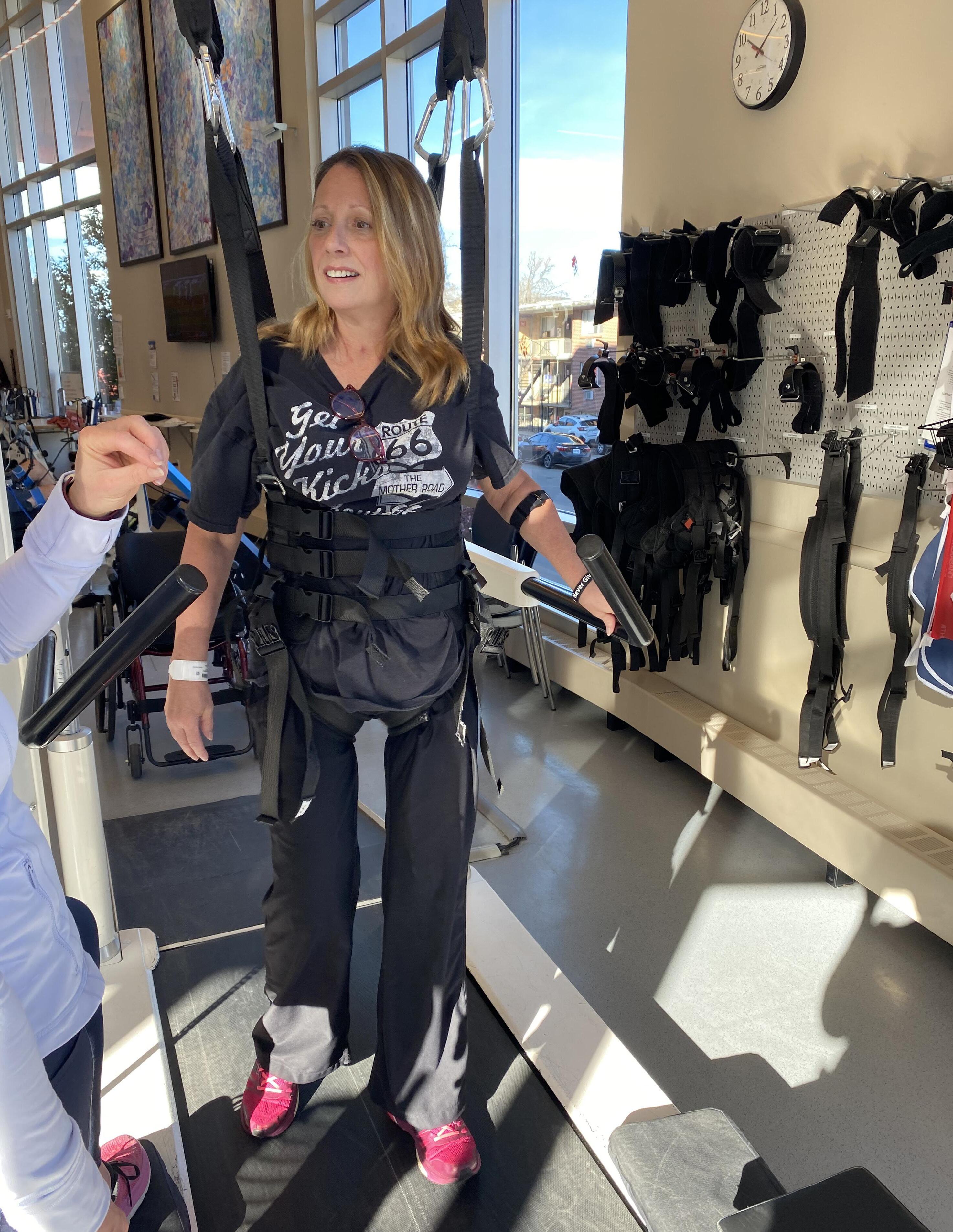
You bring strength, hope, and healing to Craig patients and families
Thank you for your generous support!
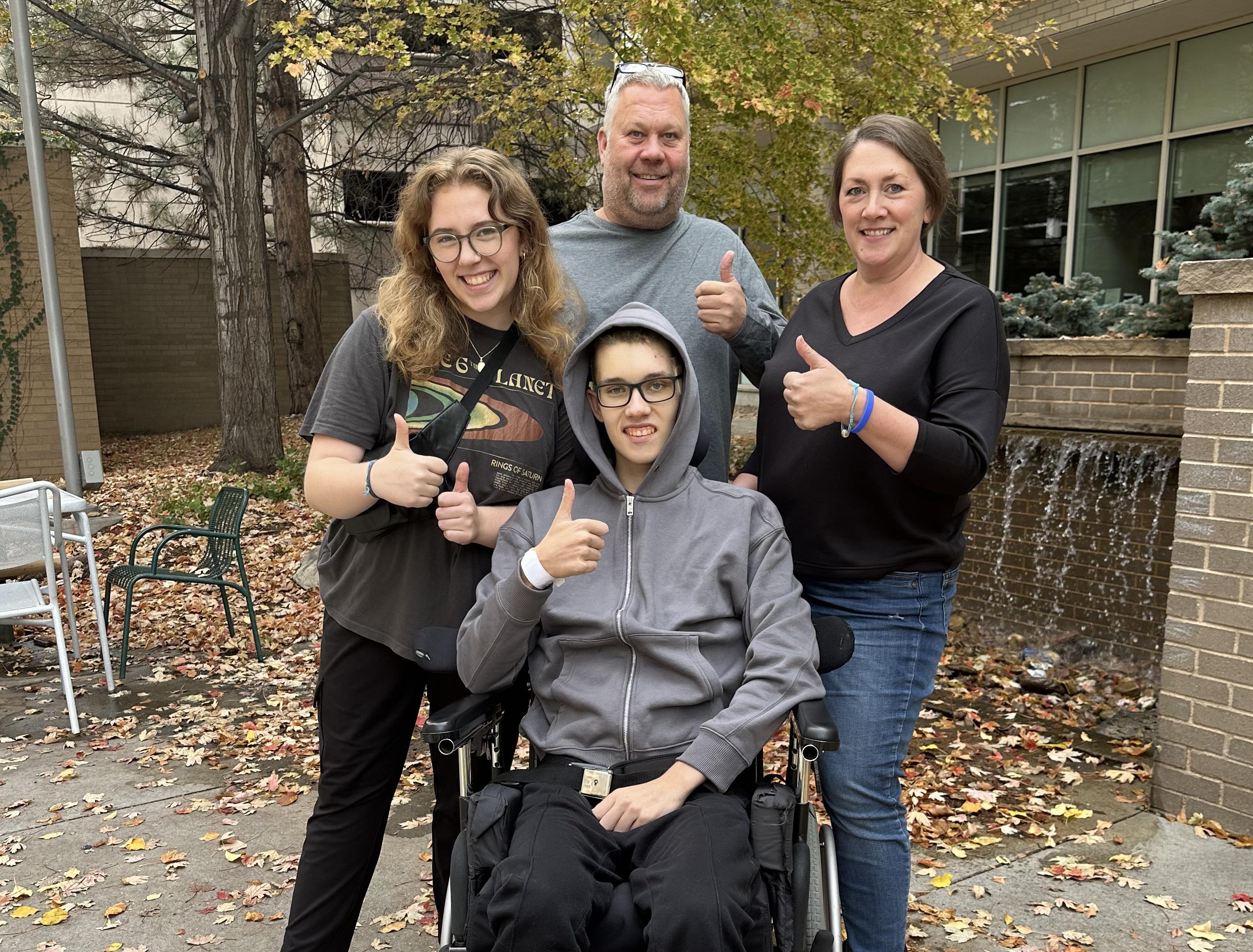


You bring strength, hope, and healing to Craig patients and families
Thank you for your generous support!

On the afternoon of Sunday, May 25, 2025, 18-year-old Jack Knudsvig delivered a speech to the senior class and received his high school diploma at the Central Valley School graduation in Buxton, North Dakota.
“I have to pinch myself,” his mother, Erica, explains. “I am so unbelievably grateful because just a few months ago, we didn’t know if this would happen for Jack.”
Less than a year earlier, Jack was driving to school when he approached a railroad crossing without any safety gates.
While he doesn’t remember anything about the accident, Jack’s SUV struck the moving train at the unmarked crossing and was dragged about 50 feet down the tracks.
His father, David, a volunteer firefighter, was the first one on the scene before Jack was airlifted to a Fargo hospital and rushed into surgery. He spent one month in the ICU before transferring to Craig Hospital for neurorehabilitation.
“Jack sustained a traumatic brain injury, as well as shattered bones below his left eye and a cracked sternum, but miraculously, he had no other injuries below his neck,” Erica says.
She adds, “We tried to focus on the positives and remain hopeful—especially in the early days following his accident. It was definitely difficult to stay positive at times, but Jack was making baby steps every day. And those steps began to get bigger and bigger after he transferred to Craig in mid-October.”


While at Craig, Jack took part in daily speech, occupational and physical therapy, as well as therapeutic recreation and the Adolescent Program, which fosters positive peer support and age-specific education and programming.
To ensure Jack graduated on time with his senior class, he participated in the donorsupported School Program. “When Jack was ready to focus on his academics, he began working with Craig teachers, Laura and Hannah,” Erica explains. “They worked with his high school to get a 504 Plan in place and helped him focus on the things that were vital for graduation, such as passing the North Dakota Civics Exam.”
While at Craig, Jack’s family stayed nearby in Patient/Family Housing. “We were so thankful to be close to Jack while he recovered,” Erica says. “I was with him the entire time, while David and my mom traveled back and forth. I appreciated being by Jack’s side all day and then having my own time at night to decompress and recharge for the next day.”
In late November, Jack returned home to North Dakota. His first stop was the Central Valley School gym, where students and teachers were gathered to celebrate Jack’s return. “It was so great to be back,” Jack explains. “I really missed everyone at school.”
Before heading back to classes in January, Jack spent time in outpatient therapy, including a return-to-driving program.
Jack plans to study mechanical engineering at the University of North Dakota in Grand Forks, located about 30 minutes from his home. “I have a lot to look forward to,” he says. “I never doubted that I’d be able to recover and graduate with my class.”
Erica adds, “There is so much to be thankful for. In addition to our wonderful family, friends and community—who came together to help us in numerous ways—we are so grateful for the amazing support we received from Craig and the Foundation. We feel very lucky.”
Tenacious, strong and brave are how the staff at Craig Hospital describe Wendy. So when she became determined to walk out of Craig on her own, there was no doubt in anyone’s mind that Wendy would achieve her goal.
And on November 17, 2023, Wendy did just that.
“I really wanted to get home in time for Thanksgiving,” she recalls. “I have to admit, it was not pretty, but I did it. I walked out slowly and awkwardly—but I walked out on my own.”
She adds, “After enduring the most traumatic and frightening experience of my life, I persevered. With a great team at Craig and a serious dose of grit, I was determined to crawl, stand, walk and thrive again. It worked! There’s no doubt I owe it all to my time at Craig.”
Thinking back to the summer of 2023, Wendy, who was 60 at the time, says it all began while she was washing windows in her Colorado home.
“I remember feeling some neck and back pain, but I just assumed it was due to reaching for high windows,” she says. “But then the next day, I fell for no reason at all. I fell again the following day, and then the intense back pain began.”
Next, came walking struggles and feelings of profound cold and paralysis traveling up her body from her feet to her mouth.
“It was absolutely terrifying,” Wendy explains. “I was admitted to the ICU, where they began running test after test to figure out what was happening to me. The paralysis took over my core functions and lungs. I was hypoxic, and I went into respiratory failure. Doctors inserted a trach and a feeding tube. I lost reflexes and muscle control before a spinal tap eliminated other possible illnesses and confirmed GuillainBarré Syndrome.”
A condition in which the body’s autoimmune responses attacks the peripheral nervous system, Guillain-Barré Syndrome (GBS) is rare. In fact, only one to two people in 100,000 are diagnosed with GBS each year.

GBS is characterized by the rapid onset of numbness, weakness and paralysis in the breathing and core muscles, legs, arms and face. Paralysis quickly travels up the limbs from toes and fingers toward the torso.
While the exact cause is unknown, researchers believe that GBS is linked to events that stress the immune system, such as viral or bacterial infections, surgery, and in some cases, vaccinations.
There are many variants of GBS, but they are all considered to be rapid onset. About 70 percent of people experience a full recovery, typically between six months to two years.
“After six weeks in the ICU, I was ready to move to Craig to begin my recovery. I was aware that my time at Craig would require grit and perseverance, but I knew I could do it. I felt like the luckiest person to be able to rehab at Craig,” she recalls.
In late September, Wendy transferred to Craig by ambulance for her neurorehabilitation. The first week was about resting, meeting her care team, and adjusting to her new surroundings. And then the work began.
“It was like training for the Olympics. There was no time to be sick at Craig. It took everything I had to sit up and move a leg, but I refused to let GBS get the best of me,” she says. “I wanted to be as independent as possible—and as fast as possible. I graduated from three different kinds
of wheelchairs to a walker. As a flight attendant who was used to traveling more than 50 percent of my life, I was accustomed to big adventures. I had no time for GBS.”
In addition to a rigorous speech, occupational and physical therapy schedule, Wendy took part in Craig’s donor-supported therapeutic recreation and horticultural therapy programs.
“When Kamryn Cushway, my recreational therapist, asked me what I like to do for fun, gardening was at the top of my list because it has always been a relaxing and enjoyable activity for me,” Wendy recalls. “Who doesn’t like to play in the dirt?”
Kamryn explains that as a recreational therapist, she always starts therapy by asking new patients what they enjoy doing in their free time. “An injury does not change your identity, it just may look a little different,” she says. “So, we strive to combine therapy with the hobbies people enjoy—and gardening was a specific interest of Wendy’s.”
I tried to step out of my own pain and misery and focus my energy on cheering for others. It was way easier to be positive and hopeful than to wallow in despair.
- Wendy, Craig Graduate
While neurorehabilitation is often a difficult journey for patients, horticultural therapy serves as a welcome respite. Patients are distracted from their pain and discomfort, while working on therapeutic goals that don’t feel like work.
“In fact, research shows that horticultural therapy provides many benefits,” explains Mattie Cryer, horticultural therapist at Craig. “These benefits include improving mood, social skills, memory and cognition; promoting emotional growth; calming the nervous system; lowering cortisol levels; improving blood pressure; relieving anxiety; initiating feelings of joy; and helping patients find a sense of purpose.”
With assistance from Kamryn and Mattie, Wendy worked on her fine motor skills and coordination, while planting flowers, pruning plants and weeding in Craig’s greenhouse and outdoor garden.
“Because Wendy is a social and positive person, she also wanted to participate in the hospital’s horticultural group,” Kamryn explains. “This
allowed her to make very strong connections with other peers, while working on her recovery.”
In addition, Wendy enjoyed the numerous therapy dogs at Craig. “I am a huge dog lover, so I enjoyed spending time with the therapy dogs,” she says. “There was nothing better than getting some puppy love to motivate and inspire you. In fact, the affection of a therapy dog—combined with the knowledge of a great OT—helped me straighten my legs during a therapy session when I was struggling with pain and reflexes.”
While Wendy found inspiration in Craig’s therapy dogs, she also became a great inspiration to others.
“With a career as a flight attendant, Wendy is used to taking care of others, which is exactly what she did at Craig,” recalls Stephanie Beinecke, Wendy’s physical therapist. “She worked so incredibly hard and had a great attitude every day. At the same time, she was a support system for other patients. She not only spent time getting to know everyone, but she consistently encouraged and motivated others. Wendy was fortunate to recover at a fast rate, and she tried to help others do the same.”
Wendy adds, “I tried to step out of my own pain and misery and focus my energy on cheering for others. It was way easier to be positive and hopeful than to wallow in despair.”
Looking ahead, Wendy feels very optimistic. She spends her time swimming and lifting weights to build strength—along with journaling about GBS and painting with acrylics. Additionally, Wendy and her husband, Jim, plan to travel and see more of the world: “It might be at a slower pace, but we plan to seek joy in small adventures.”
“I am working on every aspect of recovery and health,” Wendy says. “For now, I am just feeling so grateful. I feel thankful for Jim, who never left my side, and I feel indebted to Craig. When I first arrived, I wondered where I’d fit in because I didn’t have a brain injury or a spinal cord injury. But I didn’t need to worry at all. The knowledge and expertise at Craig is impressive.”
She adds, “GBS is rare, but my care team knew exactly how to help me recover. The hospital is full of so many enthusiastic human beings who really care. They anticipated all of my needs and helped me get my life back. This experience has been life-changing, and my heart is so full of gratitude.”
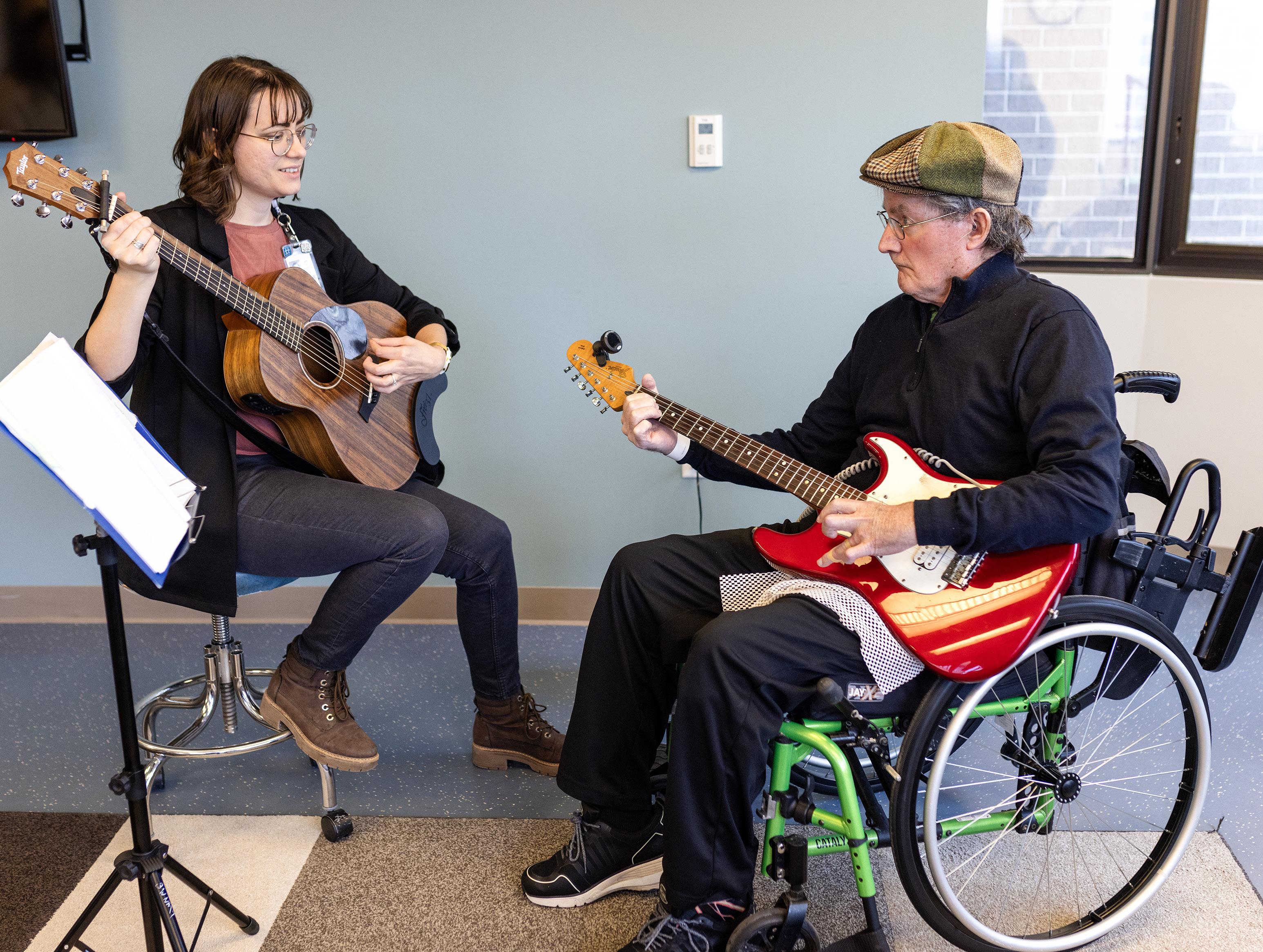
Growing up in Sioux City, Iowa, in the 1950s, Kelly Noonan was first introduced to the guitar in elementary school by Tommy Bolin.
Tommy went on to become a professional guitarist and songwriter with several bands –including Zephyr and Deep Purple – while playing guitar became a favorite hobby for Kelly.
“I have always enjoyed playing the guitar,” Kelly recalls. “In fact, every Friday for more than 25 years, I used to get together with a group of friends for a jam session.”
But those sessions came to an end in September 2023 when Kelly had a stroke that left him unable to play.
After numerous stints in different hospitals
and long-term care facilities, Kelly’s daughter, Heather, an occupational therapy assistant, decided it was time for Kelly to take advantage of Craig’s neurorehabilitation expertise.
“Not only is Craig known for being a world-class rehabilitation hospital, but it’s also located just a few miles from my dad’s house,” explains Heather. “It made perfect sense to do his outpatient therapy there. We hoped Craig would give my dad the best chance of recovery.”
In the summer of 2024, Kelly spent three months participating in Craig’s speech, occupational and physical therapy programs to relearn skills lost after his stroke.
It was in Kelly’s occupational therapy sessions that his caregiver, James Cowan, began thinking about music therapy, a donor-funded program at Craig.
“As a singer, I know firsthand how therapeutic music can be,” James says. “I strongly believed that getting back to playing the guitar would be extremely beneficial for Kelly – and his recovery.”
So Kelly’s occupational therapist reached out to Annamarie Engelhard, a board-certified music therapist at Craig.
At first, Kelly was reluctant to play. “Not only did it mean having to relearn everything from the very beginning, but it also meant learning to play with his left hand,” James explains. “But Annamarie was motivating and encouraging, and soon, Kelly became eager to play again.”
Before his stroke, Kelly, who was right-hand dominant, had always played the guitar with his left hand making chords and his right hand strumming. However, this was no longer doable.
“The first thing his occupational therapist and I did was assess the function of Kelly’s hands and see what was possible,” Annamarie explains. “After exploring several options, the best path forward was reversing his guitar. This meant restringing Kelly’s guitar ‘upside down’ and teaching Kelly to play with opposite roles for each hand. Now, his right hand plays chords, while his left hand strums. Kelly is actually relearning to play guitar left-handed as part of his rehabilitation.”
She adds, “I am teaching him to play an electric guitar – instead of the acoustic guitar that he used to play on – because it has a slimmer profile that is easier on the shoulder and is easier to push down on strings.”
Since beginning music therapy last October, Kelly has made a great deal of progress, already learning to play several songs with Annamarie.
In addition to feeling happy and proud with his progress on the guitar, Kelly has made many improvements in his clinical goals addressed in music therapy.
“Not only has his communication and cognition improved, but Kelly has better motor coordination, balance and strength,” James says. “His shortterm memory and attention are also better, and he now advocates for his needs.”
Heather adds, “At the one-year mark, we thought my dad had reached a plateau in his recovery, but we were wrong. Music therapy has been wonderful for him. He’s so happy to have a guitar in his arms and is looking forward to getting stronger, learning more songs, and playing with
other people again.”
These improvements are no surprise to Annamarie.
“Music helps us connect with others, and this connection improves our social and emotional wellbeing,” she says. “Music therapy is known for improving cognition and motor function, elevating mood and accelerating neurological recovery in stroke patients.”
With Kelly having met his goals in music therapy and his Craig sessions coming to an end, he has no plans to stop playing. In fact, Kelly is excited to begin taking guitar lessons at a nearby music school.
“Thanks to Annamarie, my dad is thrilled to be playing once again,” Heather shares. “He used to be a very good guitar player, and he has made so much progress at Craig. We don’t want to stop now!”
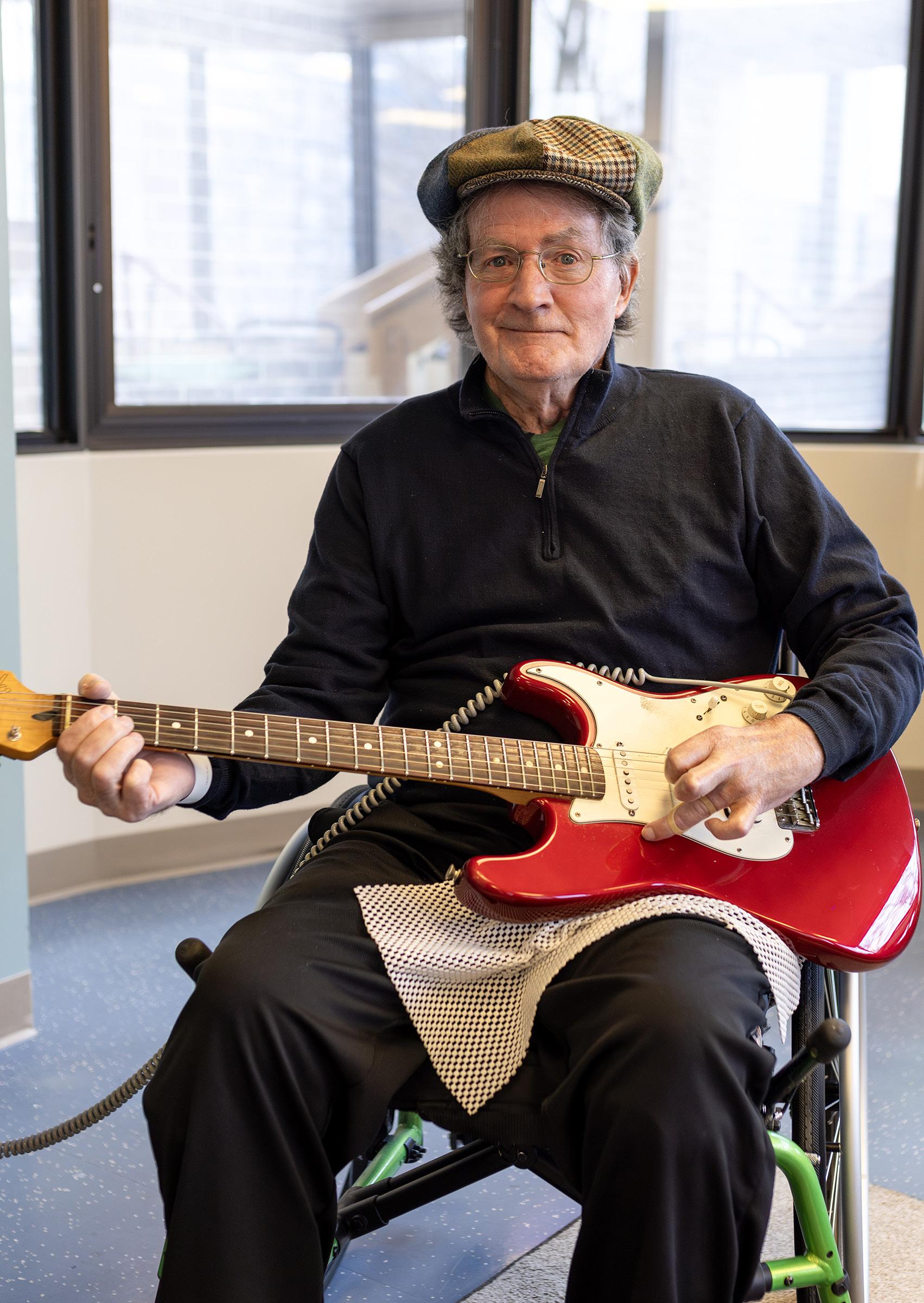

When Emily Traveller was injured in an ATV rollover accident in 2022, she was the only one to get hurt.
“I kept thinking, ‘Why me?’” recalls 19-year-old Emily. “I didn’t understand why all of my friends walked away from the accident, and I didn’t. I was a 16-year-old gymnast and cheerleader, and this was not what I’d pictured for my life.”
She adds, “I became angry and bitter and kept questioning why God did this to me. But my mom told me that God did not do this to me, but rather, God was with me. And this is how I have chosen to live my life. Today, I feel grateful to be alive. I believe that it’s important to help others and teach them what I was lucky to learn at Craig Hospital—that you must adapt to your new normal and live life as you are.”
April 22, 2022, will forever be imprinted in Emily’s memory. On this particular Friday afternoon, Emily, who was a high school sophomore at the time, traveled with some friends from her home outside of Salt Lake City to the Little Sahara sand dunes in western Utah.
After a few hours of riding ATVs, the group headed back to their car when their ATV rolled over. Emily hit her head on the roll cage bar, immediately breaking her C4 vertebrae, which paralyzed her from the shoulders down.
After being airlifted to a trauma hospital, Emily underwent surgery to stabilize her neck. “While in the ICU, my doctors told my parents that I needed to go to Craig,” she says. Shortly after, Emily flew to Colorado to begin four months of spinal cord injury rehabilitation.
“When I first arrived at Craig, I had no function below my neck. I couldn’t do anything for myself, and I lived each day in my little, isolated bubble,” she explains. “But then I started to slowly feel like myself again and began interacting with others around me.”
So many people stop living after a life-changing injury, but you don’t have to. You can still get out and do things. Life is not over, and I want to inspire people to never give up, despite the difficult obstacles they must face.
- Emily Traveller, Craig Graduate
She adds, “I began to accept my injury and started to learn everything that Craig had to teach me. My mindset turned from negative to positive, and I realized that life was not over for me. My care team at Craig had a lot to teach me about living life. As a very active and athletic person before my injury, I thought that part of my life was over, but it wasn’t. Nobody wants to be in this situation, but if you have to be, Craig is definitely the place to recover.”
When Emily returned home to Utah, her father, John, who runs his own contractor business, had fully modified the family home to accommodate Emily’s needs.
“At first, being back home was very difficult,” she recalls. “All of my friends were still cheering—something that I would normally be doing. But over time, I accepted that my life was different. I had to remind myself that nobody else’s world stopped…only mine did.”
Emily decided to do her junior year online and returned to school for her senior year: “Thanks to Laura Magnuson in Craig’s [donor-supported] School Program, I did not fall behind in school and graduated on time with my class.”
She also spent time relearning the activities she had always loved, such as biking, skiing and waterskiing. “I have pushed myself really hard to get where I’m at today,” she says. “Obviously, I am not fully functioning, but I feel like I’m doing well for my injury level.”
And Emily clearly proved that back in September when she climbed Mount Timpanogos, the second-highest mountain in Utah’s Wasatch Range, with an elevation of just under 11,800 feet.
“I hiked about 14 miles and 4,400 feet of elevation gain using a Cascade Tandem Hiking Cart from Huckleberry Hiking,” Emily explains. “I completed the 12-hour hike, with many breaks, thanks to my amazing support system of family and friends. They took turns helping to pull the cart all the way up the mountain.”
She adds, “Not only was I excited to climb Mount Timpanogos, but I also wanted to show others what’s possible. So many people stop living after a life-changing injury, but you don’t have to. You can still get out and do things. Life is not over, and I want to inspire people to never give up, despite the difficult obstacles they must face.”
And it’s this mindset that has inspired Emily to build a career in public speaking. “My story is unique. I was forced to grow up quickly and realize what’s truly important. You learn a lot from an injury like mine, so I want to teach others about awareness, positivity and perspective. I believe I have some valuable lessons to teach.”
You can follow Emily’s journey through her Instagram @emilytrav or her TikTok @emily.traveller

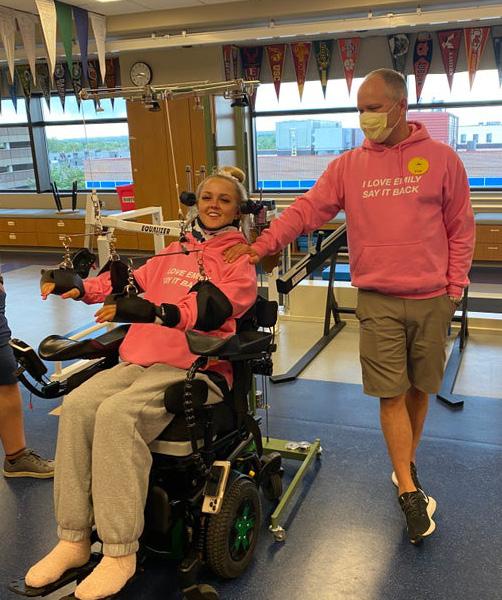

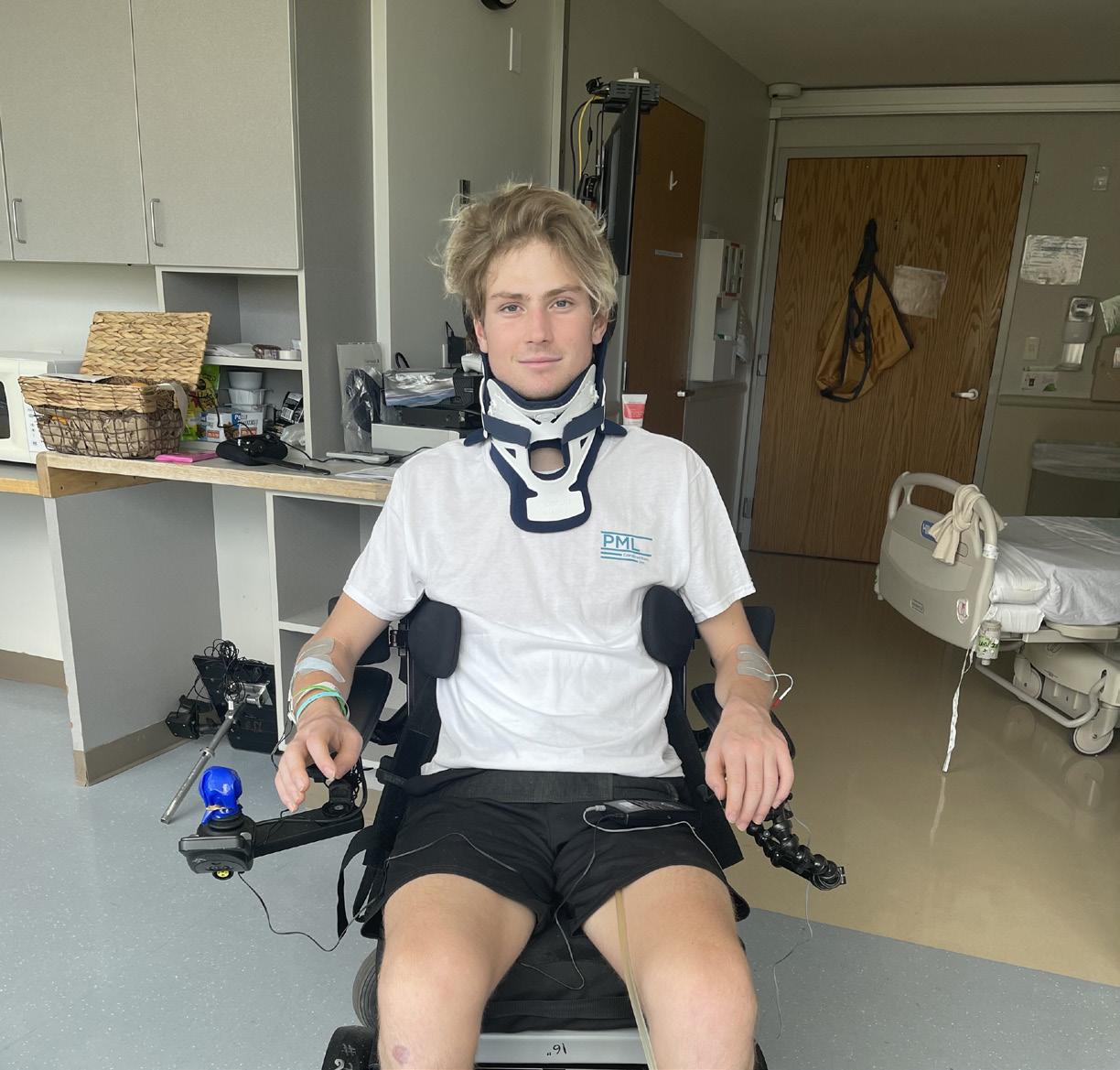
“To say our family has been changed through this journey is an understatement,” Cheri Hassenstab says. “Life was very quickly put into perspective with Emmett’s accident. We will always be grateful for our moving arms, legs, hands, fingers, wrists and ankles. We will always be thankful for all of the amazing people we have met through this experience.”
Tom Hassenstab adds, “The impact that Craig Hospital had on our family was life changing. And that’s why choosing to donate to the Craig Hospital Foundation was a very easy decision for us. We love giving to organizations that change peoples’ lives—which is exactly what Craig does.”
The Hassenstab family’s journey began back in May of 2021. After completing his junior year at Skutt Catholic High School in Omaha, Emmett traveled to Sanibel Island, Florida, with his best friend, Jake Hegge, and Jake’s family. The plan was to spend a week in Florida, enjoying the lazy days of summer.
On the very first day of vacation, Emmett, Jake and Jake’s cousins hit the resort pool. Emmett dove into the shallow end of the pool at a sharp angle, smacking his forehead on the bottom and
immediately sinking. While still conscious on the bottom of the pool, he quickly realized he couldn’t move his body.
One of Jake’s cousins saw Emmett on the bottom and told Kristin Hegge, Jake’s mother and a former ER nurse. Recognizing that something was wrong, she yelled at Jake to grab Emmett and bring him to the surface.
Jake immediately pulled Emmett from the pool floor and another adult, who was a physician’s assistant, helped lift Emmett from the water.
Within a few minutes, an ambulance arrived to rush Emmett to the fire station to meet a helicopter, which would fly him to a hospital in nearby Fort Myers. Kristin then called Emmett’s parents, who were vacationing in Colorado with family. They caught the first flight out of Denver and arrived in Florida several hours later.
Emmett’s MRI confirmed an incomplete C3-C4 spinal cord injury. While Emmett’s doctors in Fort Myers recommended a wait-and-see approach to his injury, his family decided to act. They phoned a family friend, who connected them with a spine surgeon in Philadelphia who agreed to do surgery on Emmett, operating one week after Emmett’s accident and fusing his C3 and C4 together with titanium.
About 10 days later, Emmett flew to Craig for spinal cord injury neurorehabilitation. “We looked at several rehab hospitals, but we decided on Craig because it was close to my family and because it offers an adolescent program,” Cheri explains. “We felt like having teenagers close in age to Emmett would be helpful for his recovery, and we were right.”
She adds, “At first, Emmett said he had no interest in spending time with other teens at Craig, but on our first day, four boys in wheelchairs rolled into his room to welcome Emmett to Craig. After hanging out as a group that evening, Emmett turned to me and said, ‘Mom, this is going to be great. I’m happy to have friends in the same boat as me.’”
While at Craig, Emmett worked tirelessly. With his sights set on walking again, he eagerly and diligently participated in seven hours of therapy a day, including occupational therapy, physical therapy and aquatic therapy. “While he wasn’t originally thrilled with the idea of getting back into a pool after his accident, Emmett overcame his fears and spent a lot of time working in the pool,” Cheri says. “In fact, he spent most of his time at Craig working.”
In early July, his efforts began to pay off when he took his first unassisted steps, wearing just a gait belt. The Hassenstabs were ecstatic. “Seeing your toddler walk for the first time is memorable, but seeing your 17-year-old walk for the second time is emotionally indescribable,” Tom recalls.
In addition to numerous therapies, Emmett spent time in the teen recreation room playing pool and air hockey with his friends. He also met with Laura Magnuson, Craig’s donor-supported School Program teacher, once a week to prepare for his senior year. “They talked a lot about what returning to school would look like and made sure Emmett had any needed accommodations in place,” Cheri says.
In mid August, Emmett moved into his parent’s
donor-supported family housing apartment and participated in outpatient therapy for one week before being discharged. About 90 days after his accident, Emmett walked out of the hospital on his own—and headed home to Omaha without a wheelchair.
When Emmett returned home, he continued seeing a rehabilitation doctor and a physical therapist. “While he had always dreamed about being a Division 1 track and field athlete in college, it became clear that his coordination was not what it once was,” Cheri explains. “But he accepted this and decided to attend the University of Nebraska at Lincoln. He just finished his sophomore year and currently owns a window washing business with a partner.”
Looking back on 2021, Cheri says that Emmett’s accident put a lot in perspective for the Hassenstabs.
“The accident made our family much closer,” Cheri says. “We are a spiritual family and relied on our faith to get us through. Emmett is a true miracle—and we all feel so lucky. Craig gave Emmett the freedom and assistance to work as hard as he wanted. They supported him 100 percent and gave him the guidance and confidence to achieve his goal of walking again.”
Tom adds, “Leaving Craig was so difficult because it felt like we were leaving our family. We saw firsthand how Craig helps patients recover and get their lives back. They are true experts, and we feel forever grateful for what they did for Emmett and for our entire family.”

